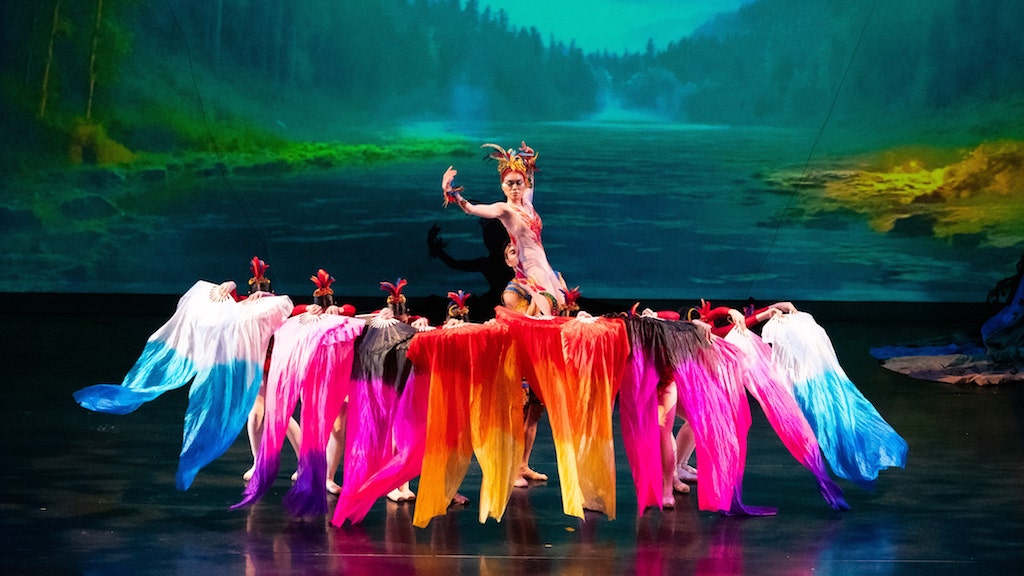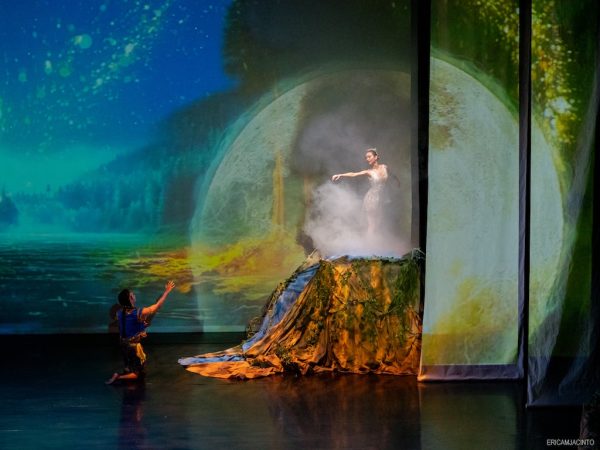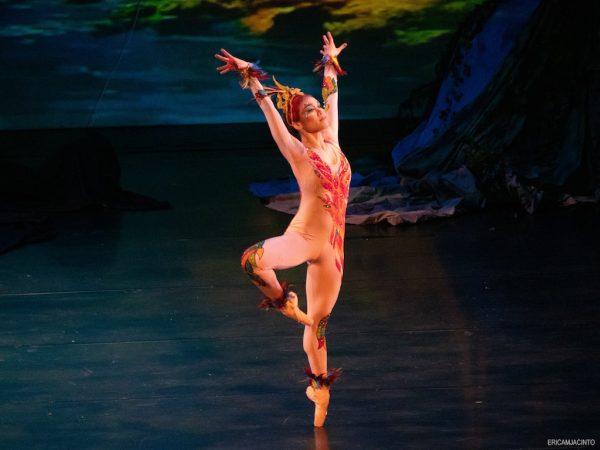
REVIEW: ‘Sarimanok’s’ potential outshines its execution
While a new original Filipino ballet is always good news, one came away from Sarimanok with the feeling that the Maranao influence was surface-level, focusing more on form than content.
This audience member excitedly came into the theater with memories of an inspired Ibalon and a gorgeous Nutcracker, two of the most recent offerings by the Philippine Ballet Theatre (PBT). Sadly, this newest addition to PBT’s repertoire has little to recommend it to ballet lovers, apart from well-rehearsed dancers and one or two genuinely beautiful musical highlights.
The sarimanok, symbol of the Maranao people, is a colorful bird that serves as the medium between Heaven and Earth. Despite it being the titular character of the ballet, the story centers on two lovers (the very young Matthew Davo as Rajah Indarapatra and an endearingly ethereal Gabbie Jaynario as the Moon Goddess) a lot more than their bridge, the colorful Sarimanok (skilfully danced by Jessa Tangalin) sent to bid the rajah come to his new lunar abode.
Half-and-half
We first see young prince Rajah Indarapatra carving a wooden bird, soon joined by his brother Rajah Sulayman (portrayed by Justine Orande). They both go to a visually stunning court, where their subjects pay homage in a suite of dances, each one featuring a unique prop to the Maranao. First came the Aper Fan Dance (originally the Maranao Kapagapir-apir), followed by the Malong Dance (from Kappa Malong-malong), and the ultimate dance of (female) royalty, the Singkil.
This viewer had to overcome a bit of cognitive dissonance with PBT’s take on neoclassical dance, because the hands and poses of the dancers’ upper torsos were so familiar as per tradition, but then the legs and toes were classic ballet with turnouts and pointe work. Half Filipino, half Western; the dancers embodied in physical form what the contemporary Filipino soul struggles with: identity.
A story is told about the moon goddess who bathes in the lake every Friday. Indarapatra visits what at first seems like a firefly-festooned moonlit scene, until the insects turn into white-clad fairies with echoes of Swan Lake. The moon projection grows larger and larger until the moon goddess herself emerges, and joins the prince for the highlight of the evening: their pas de deux.

Matthew Davo as Rajah Indarapatra, Gabbie Jaynario as the Moon Goddess; Photo Credit: Erica Feliz Marquez-Jacinto
Sadly, she cannot stay, but transforms the prince’s wooden chicken into the sarimanok, a being both of earth and sky. Hunters try to kill it, but Indarapatra realizes it is his wooden sculpture transformed by his love. A trip to the moon sets the final scene: a white castle and corresponding costume changes by the ensemble as the stage fills with beautiful dancers clothed in white raiment, brows adorned with tiaras. Would that their dance steps inspired the same intake of awed breaths as their apparel.
Music and Movement
There was a glaring lack of Maranao influence in Paulo Zarate’s music. While truly beautiful in some parts (the piano melody in the pas de deux can make even the most jaded heart believe in true love), there were only one or two dances where gongs barely resembling the expected kulintang could be heard, and the singkil rhythm presented. The rest seemed a mishmash of Arab harmonic minor and Chinese pentatonic scales, or scored as if for a generic Hollywood movie.
Particularly noteworthy was Zarate’s changing every fourth repetition of the rhythmic ostinato in the singkil. While the first three patterns were syncopated as per tradition, the fourth rep was different. And it visibly caused turmoil amongst the dancers and their comrades on the bamboo poles. One felt that the polemen were trying their best to close the bamboo poles as gently as possible, so as not to cause injury on fragile toes when the dancers stepped between them en pointe, and there was lack of synchronization on every fourth rep as the physical movements of the poles did not match the music’s rhythm.

Eloisa Jessa Tangalin as Sarimanok; Photo Credit: Erica Feliz Marquez-Jacinto
In terms of choreography, while the dancers were mostly well-rehearsed (except for the problematic Singkil where one could feel their trepidation from the stage), Sarimanok’s ensemble pieces were overly simplistic. Whether it was a question of prioritizing cleanliness over fancy maneuvers, or whether the vast number of young dancers onstage needed choreography more suited to their not-yet-mature technique, viewers only know that we could almost predict what motion would happen next. It seemed as if the emphasis was on hitting pretty poses, which photograph well. But viewed as a whole, the dances mostly left this viewer unmoved and unsatisfied. The one satisfying highlight was undeniably Davo and Jaynario’s moonlit dance, where mortal and goddess fell in love with each other (and the audience with their magical tandem).
While a new original Filipino ballet is always good news, one came away from Sarimanok with the feeling that the Maranao influence was surface-level, focusing more on form than content. In a country known for its artistic wealth, this latest offering was sadly underwhelming.
Tickets: P360 – P2,575
Show Dates: July 6-7, 2024 (3:00 PM / 8:00 PM)
Venue: Samsung Performing Arts Theater (Stage), Circuit Makati
Running Time: 110 minutes (including a 10 minute intermission)
Credits: Ronilo Jaynario (Artistic Director and Choreographer), Paulo Zarate (Composer and Music/Audio Tech Consultant), Therese Jaynario and Erica Jacinto (Rehearsal Mistresses), Michael Gregorio (Production Manager), Roldan Lozano (Technical Director and Lighting Designer), Julie Borromeo (Costume Design and Execution), Enrico Navarro and Fortunato Co (Animators, Special Effects and Creative Design), Ysabel Sabas (Stage Manager), Joseph Pimentel (Graphic Designer), Arni Montinola (Set Execution)
Cast: Matthew Davo / Jimmy Lumba (Rajah Indarapatra), Gabrielle Jaynario / Joanna Isabel Galeste (Moon Goddess), Eloisa Jessa Tangalin / Gladys Baybayan (Sarimanok), Justine Joseph Orande / Dominador Delmo (Rajah Sulayman), including Renee Antonie Aguilar, Sarah Filippa Belgica, Isabela Gabrielle Bellosillo, Sophie Bunquin, Isabela Caringal, Tory Gil Emilio Cortez, Margarette Espiritu, Julafer Fegarido, Adriana Guinto, Ian David Hormillosa, Dexter Igares, RJ Igares, Dustin Igares, Alessandra Jacinto, Kimberly Manguiat, Marynce Cassidee McCann, Lani Pelovello, Ace Christian Polias, Margarita Prado, Therese Riego, Eira Joanne Tangalin, Sophia Martina Tiangco, and Tracey Yoanna Toral
Company: Philippine Ballet Theatre


Comments